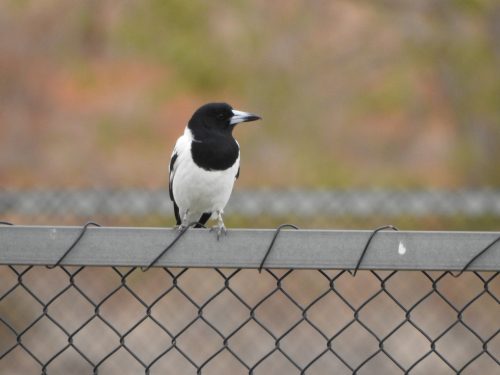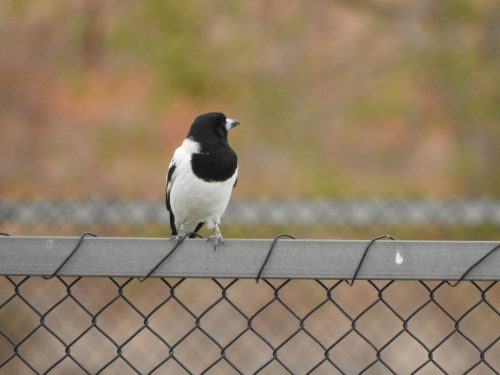Masked Lapwing flyover
I’ve just come inside after hanging out a load of washing. While this necessary task interrupts my writing, I do welcome and enjoy it. Firstly, it stretches my legs and gets me out of my chair and away from the computer for a few minutes. Then I enjoy the breath of fresh air. Finally, it allows me to be outdoors with my head up – always a good pose for birding.
This morning’s delight was two (a pair?) of Masked Lapwings (plovers) flying noisily just over my head. This is a very common species in this area, but strangely, we don’t often get them landing on our 5 acre block of land. They also don’t often seem to fly directly overhead either. We usually only hear them in the distance.
Last week on a visit to the nearby Monarto Zoo I photographed a Masked Lapwing sitting on a nest. In another enclosure we saw a pair escorting three young chicks. I hope they didn’t venture into the nearby cheetah enclosure!
Related article:
- Masked Lapwings -articles about lapwings from my archives.
Banded Lapwings, Murray-Sunset National Park
Last year we went on a four week holiday through New South Wales and Victoria. I’ve written about that holiday on a number of previous occasions.
When we left Mildura in north west Victoria we didn’t follow the main highway home. Instead, we drove through parts of the extensive Murray-Sunset National Park. This park is mainly mallee scrub, with some open saltbush plains in places. As we were driving along the dirt track I managed to add a number of species to my trip list. One of these was the elusive Banded Lapwing, shown in the photo above.
Banded Lapwings have been something of a bogey bird for me, and I’ve only recorded it on a handful of occasions. Mind you, this is not really all that surprising, for while it is widespread in southern Australia, it is not common anywhere in its range. It is absent in the far tropical north of the continent.
Banded Lapwing’s preferred habitat is open, stony or ploughed ground or ground with short grass. The photo above shows the vegetation where I saw the Lapwings and this would be typical of its usual habitat. It is often encountered in small groups; only once have I seen a group of about fifty birds. It usually breeds in the months of June through to October, or after rain, and lays 3 – 4 eggs in a scrape on the ground sometimes with a little grass lining.
It is somewhat smaller than its more common and more aggressive cousin, the Masked Lapwing.
Reference:
- Pizzey, G and Knight F: The Field Guide to the Birds of Australia
Lapwings and lunch by the lake at Lameroo
2007 New South Wales Trip Report #2
Lunch at Lameroo:
On quite a number of occasions we have pulled into a lovely park on the eastern edge of the mallee town of Lameroo for lunch or a cuppa. This park has a small artificial lake called Lake Roberts. This time we arrived in perfect time for lunch. As we drove through the town I saw Rock Doves flying around the wheat silos and House Sparrows near the houses.
As we drove into the park we observed two Masked Lapwings feeding on the grassed area. Later I saw a fluffy baby being closely guarded by the observant parents. A lone Willie Wagtail was feeding on the grass around the lake while a single Great Cormorant sat resting on the bank.
Welcome Swallows swooped over the lake as we ate our lunch. We tried to ignore the gathering company of non-Australian ducks at our feet; they were getting none of our lunch. They included a motley assembly of various domestic breeds of ducks; at least one of them was a male Mallard. I saw several Red Wattlebirds and heard a large flock of Weebills feeding in the tree near our picnic site. Several Australian Magpie Larks searched the water’s edge for their lunch and I heard a Grey Shrike-thrush and a Spiny-cheeked Honeyeater off in the distance. A small flock of Galahs flew overhead as we left. A Singing Honeyeater perched atop a nearby tree and watched us as we packed things back in the car.
I tried to get a photo of a Black-backed Magpie, but the ducks chased it off before I could focus.
It was a lovely start to our holiday trip. More tomorrow.
Lapwings Living Dangerously
On my way to a friend’s place this afternoon my car was “attacked” by an angry Masked Lapwing. I slowed right down to make sure I didn’t drive over it.
A few metres from the edge of the road was the reason for all the aggro. A tiny golf ball sized bit of fluff on legs was trying to cross the road. It made it successfully to the other side before another car came along. It too, was attacked by the very defensive parent.
This incident reminds me of a similar sighting over ten years ago. It was at possibly the busiest intersection in Adelaide. For those of you who know Adelaide it was the North Terrace, West Terrace, Port Road intersection. The very brave Masked Lapwing parents were trying desperately to keep their two little ones on the triangular grass medium strip. Trying to cross six or eight lanes of busy Saturday afternoon traffic would not have been a good career move. Of course, I was not able to witness what happened. I had to go with the flow of traffice and not sit there bird watching.
Pied Butcherbirds
I have recently travelled from my home in Murray Bridge, South Australia to Sydney. Along the way I stopped many times to do some birding and, where possible, take some photos of the birds I saw. On the first day of my journey, I stopped for lunch at Lake Cullulleraine which is a small community on the banks of this lovely lake. It is about a half hour drive west of Mildura in the far north-western part of Victoria.
After having my lunch I slowly drove around the area adjacent to the lakeside picnic area. In this part of the small town is a well-kept football oval as well as grass tennis courts. I saw a few Red-rumped Parrots. a small group of Masked Lapwings patrolling the grass and several Australian Magpies and Magpie Larks. On the netting around the tennis courts, I saw perched an adult plumage Pied Butcherbird. This bird is the subject of today’s photos.
Grey Butcherbirds are relatively common and widespread in the area where I live. But for Pied Butcherbirds, I generally have to travel some distance north or east to see this species, though I have recorded it once just south of Murray Bridge. Grey Butcherbirds are regular visitors to my garden but I have never recorded a Pied Butcherbird at home. My records go back over 35 years. On the rest of my journey to Sydney, I saw Pied Butcherbirds frequently as I drove along. On the other hand, where I am staying in Artarmon, Sydney, I have only ever seen Grey Butcherbirds despite both species being present throughout this area. This is probably just a case of not being in the right place at the right time.
For further reading, just click on one of the bird species mentioned in this post.
Good birding,
Trevor.






